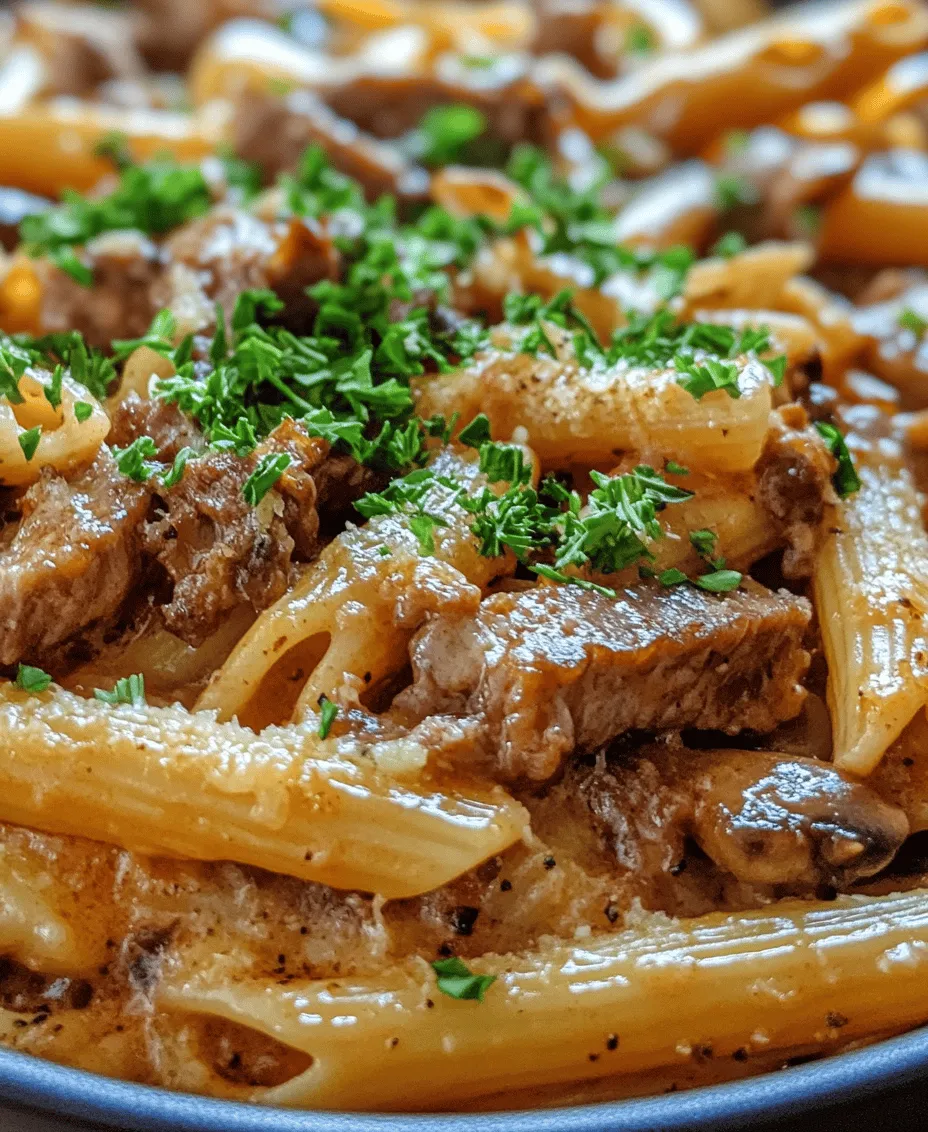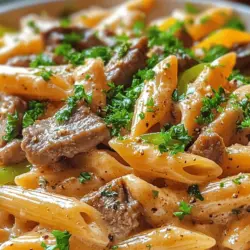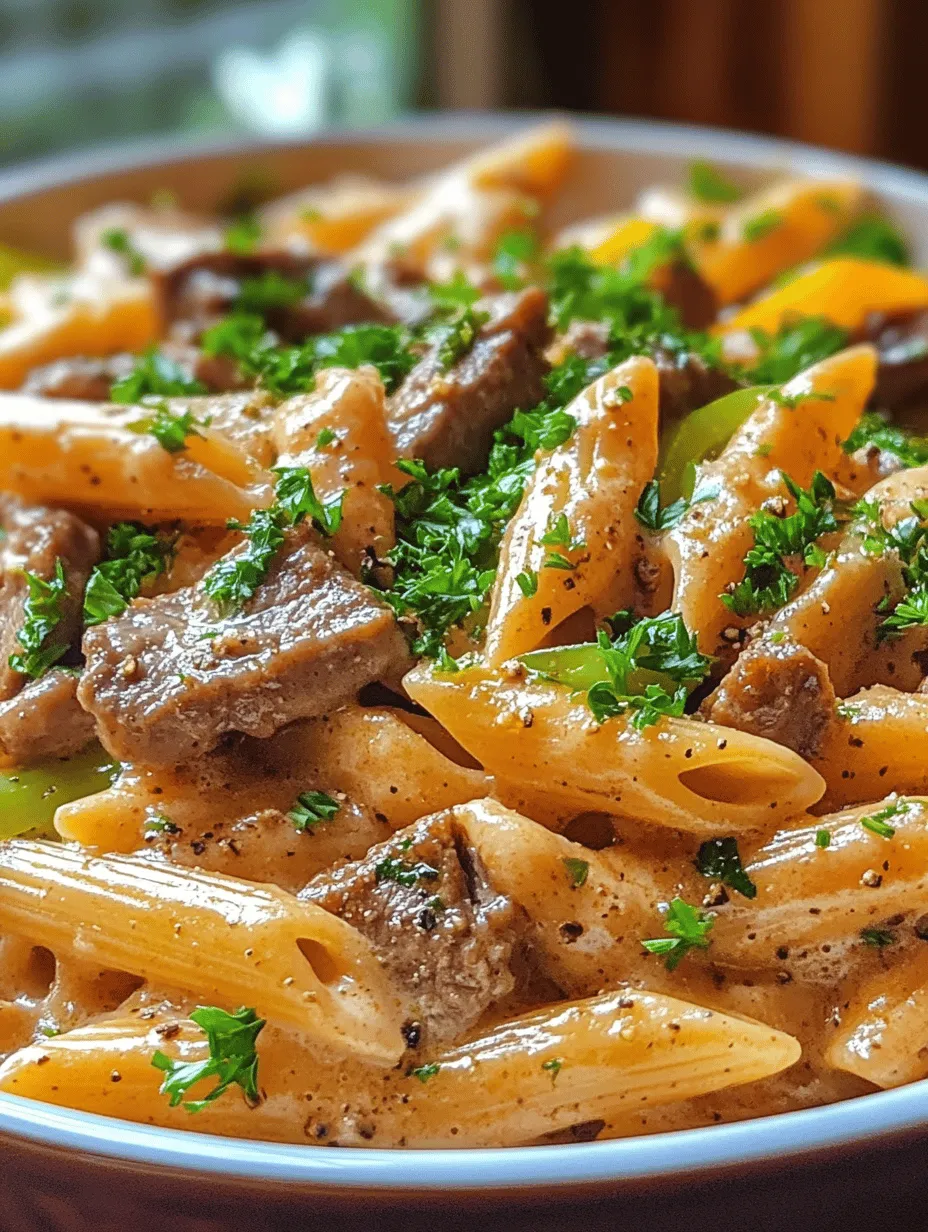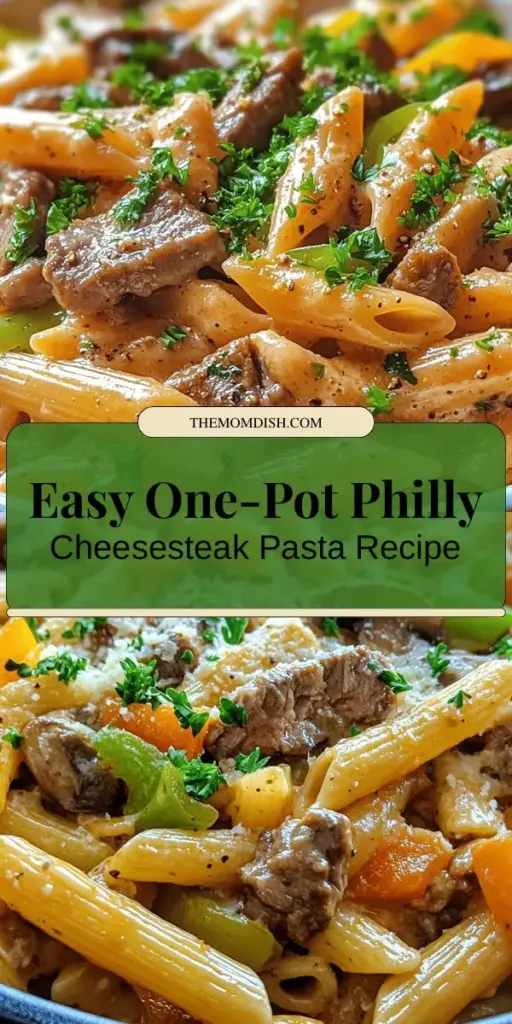Introduction
If you’re a fan of rich, savory flavors and comforting meals, then the One-Pot Philly Cheesesteak Pasta is bound to become your new go-to dish. This culinary creation melds the classic elements of a Philly cheesesteak — tender steak, sautéed vegetables, and creamy cheese — with al dente pasta, all cooked conveniently in a single pot. Its roots trace back to Philadelphia, where the cheesesteak sandwich reigns supreme, known for its delicious combination of beef and melted cheese. By transforming this beloved sandwich into a pasta dish, we create a hearty meal that is not only satisfying but also quick to prepare.
One of the standout benefits of a one-pot meal is the simplicity it offers. You can cook everything in one vessel, minimizing cleanup and maximizing flavor. The ingredients meld beautifully, allowing each bite to be a perfect balance of savory steak, vegetables, and creamy cheese. Whether you’re a busy professional, a parent juggling family meals, or simply someone who enjoys easy cooking, this One-Pot Philly Cheesesteak Pasta is an ideal solution. With its quick preparation time and minimal cleanup, it fits seamlessly into the hustle and bustle of modern life without compromising on taste.
In this article, we’ll explore the allure of one-pot meals, break down the essential ingredients that make this dish so special, and guide you through the step-by-step cooking instructions that will have your taste buds dancing with delight.
Exploring the One-Pot Concept
Definition of One-Pot Meals and Their Appeal
One-pot meals are exactly what they sound like: dishes that are prepared using just one cooking pot. This concept embraces the idea of cooking all components of a meal together, allowing flavors to blend and create a cohesive dish. The appeal of one-pot meals lies in their simplicity and convenience. For many home cooks, the thought of preparing a meal that requires multiple pots and pans can be daunting. One-pot meals eliminate that stress, making cooking a more enjoyable experience.
Benefits of Cooking Everything in One Pot
The benefits of one-pot cooking extend beyond just ease of preparation. Here are a few key advantages to consider:
– Time-Saving: Preparing a one-pot meal typically takes less time than multi-pot cooking. You can chop, sauté, and simmer all in one go.
– Easier Cleanup: With just one pot to wash, cleanup becomes a breeze. This is particularly appealing after a long day when the last thing you want to do is tackle a mountain of dishes.
– Flavor Infusion: Cooking all ingredients together allows for the flavors to meld, creating a more robust and harmonious taste profile. Each component enhances the others, making every bite a delight.
Popularity of One-Pot Meals in Modern Cooking
In recent years, one-pot meals have surged in popularity. Busy lifestyles have led many to seek out recipes that deliver on taste and ease. With the rise of social media and food blogs, home cooks are eager to share and discover new one-pot recipes that fit their needs. Dishes like One-Pot Philly Cheesesteak Pasta have found their way into many kitchens, not just for their deliciousness but also for their practicality. Families and individuals alike appreciate the ability to create a hearty meal without the fuss, making one-pot meals a staple in modern cooking.
Ingredients Breakdown
The magic of One-Pot Philly Cheesesteak Pasta lies in its carefully selected ingredients. Each element plays a vital role in delivering the dish’s signature flavor and texture. Let’s take a closer look at the key ingredients that come together to create this culinary delight.
Introduction to the Key Ingredients
To achieve the best results, it’s essential to focus on the quality of your ingredients. Fresh, high-quality components not only enhance the flavor but also contribute to the overall texture of the dish. Here’s an overview of what you’ll need for this recipe:
– Penne Pasta: The backbone of the dish, penne pasta is ideal due to its tubular shape, which holds the sauce beautifully. Its cooking time aligns perfectly with the other ingredients, making it a logical choice for this one-pot meal.
– Thinly Sliced Steak: For the meat component, options like ribeye or sirloin are preferred. These cuts are tender and flavorful, providing the rich taste that embodies a traditional Philly cheesesteak.
– Vegetables: This recipe incorporates onion, bell pepper, and mushrooms. Each vegetable adds unique flavors and textures, while also boosting the nutritional value of the dish.
– Seasoning: The blend of Worcestershire sauce, soy sauce, and Italian seasoning elevates the dish, creating a depth of flavor that ties everything together.
– Cheese: Provolone cheese is the star here, providing that gooey, melty finish we crave. The addition of cream cheese adds creaminess and richness to the sauce.
– Fresh Parsley: Finally, fresh parsley is used as a garnish. Not only does it add a pop of color, but its bright flavor balances the richness of the dish.
Detailed Descriptions of Each Ingredient
Penne Pasta
Penne pasta, with its ridged surface and hollow shape, is perfect for this dish. It holds onto the creamy sauce beautifully, ensuring that every bite is packed with flavor. Cooking penne typically takes around 11-13 minutes, making it a quick-cooking option that allows you to whip up this dish in no time.
Thinly Sliced Steak
When it comes to the meat, thinly sliced steak is essential for achieving that authentic cheesesteak experience. Ribeye is known for its marbling and tenderness, while sirloin offers a leaner option without sacrificing flavor. Regardless of your choice, ensure the steak is sliced thinly against the grain for the best texture and to promote even cooking.
Vegetables
– Onion: Sautéed onions add a natural sweetness and depth of flavor to the dish. They caramelize beautifully, enhancing the overall taste profile.
– Bell Pepper: The vibrant colors of bell peppers not only make the dish visually appealing but also bring a slight crunch and a hint of sweetness. Choose a mix of colors for a beautiful presentation.
– Mushrooms: Mushrooms add an earthy flavor and contribute to the overall umami taste of the dish. They absorb the flavors of the broth, making them a fantastic addition.
Seasoning
The seasoning blend is crucial for achieving the signature cheesesteak flavor. Worcestershire sauce provides a savory depth, while soy sauce adds a hint of umami. Italian seasoning ties the flavors together, creating a well-rounded taste that complements the other ingredients.
Cheese
A blend of provolone and cream cheese creates a creamy, indulgent sauce that envelopes the pasta and steak. Provolone melts beautifully, while cream cheese ensures a smooth texture. Together, they create the decadent finish that makes this dish irresistible.
Fresh Parsley
Fresh parsley not only serves as a garnish but also adds a refreshing note to balance the richness of the dish. Its vibrant green color brings brightness to the plate, making the meal even more appetizing.
Step-by-Step Cooking Instructions
Now that we’ve covered the ingredients, let’s dive into the cooking process. Follow these detailed steps to create your own One-Pot Philly Cheesesteak Pasta.
Cook the Vegetables
Start by heating a drizzle of olive oil in a large pot or Dutch oven over medium heat. Add the chopped onions and cook until they become translucent, about 3-4 minutes. Next, add the sliced bell peppers and mushrooms. Sauté the mixture for another 5-7 minutes until the vegetables are tender and slightly caramelized. This step is crucial as it develops the flavor base for the entire dish. The sweet and savory notes from the sautéed vegetables will elevate the entire meal.
Brown the Steak
Once the vegetables are cooked to perfection, push them to the side of the pot and add the thinly sliced steak. Allow the meat to sear for about 2-3 minutes without stirring, letting it develop a nice crust. Then, using a spatula, give it a quick stir to brown the other side. The goal here is to get a good sear on the steak while ensuring it remains tender. Overcooking will lead to tough meat, so keep a close eye on it.
Add the Pasta and Liquids
With the vegetables and steak ready, it’s time to add the penne pasta and the liquids. Pour in your broth (beef or chicken works well) and add enough to cover the pasta. You can also incorporate Worcestershire sauce, soy sauce, and Italian seasoning at this stage. Stir everything together, ensuring that the pasta is submerged in the liquid. Bring the mixture to a boil, then reduce the heat to low, cover the pot, and let it simmer. Cooking the pasta in broth infuses it with flavor, resulting in a deliciously savory dish.
As the pasta cooks, it will absorb the flavors from the steak and vegetables, creating a cohesive and satisfying meal. This one-pot wonder is not only easy to make but also promises a depth of flavor that will leave you craving more.
—
In this first part of our detailed recipe article for One-Pot Philly Cheesesteak Pasta, we have uncovered the origins of the dish, explored the benefits of one-pot cooking, and broken down the essential ingredients. We’ve also provided step-by-step instructions that set the stage for a delicious meal. Stay tuned for the next part, where we will continue with detailed cooking instructions and tips for achieving the best results in your kitchen!

Simmer: The Importance of Simmering for Proper Texture
Once you’ve combined all the ingredients in your pot, the next crucial step is to let your One-Pot Philly Cheesesteak Pasta simmer. Simmering is essential because it allows the pasta to absorb the flavors of the broth and the seasonings, leading to a harmonious blend that enhances the overall dish. It typically takes about 10-15 minutes on low heat, during which you’ll want to keep an eye on the consistency.
As the dish simmers, the starches from the pasta will thicken the sauce, creating a luscious and creamy texture. A gentle simmer—rather than a vigorous boil—ensures that the pasta cooks evenly without becoming mushy. Stir occasionally to prevent sticking and to ensure that every noodle is coated in the savory sauce. The result is a perfectly textured pasta that retains its shape while being infused with all the delicious flavors from the other ingredients.
Incorporate Cream Cheese: How to Achieve a Creamy Consistency
To elevate the creaminess of your One-Pot Philly Cheesesteak Pasta, the incorporation of cream cheese is vital. Once your pasta has simmered and is almost cooked through, reduce the heat to low and begin to add the cream cheese. This will not only enhance the dish’s creaminess but will also add a subtle tang that complements the savory flavors of the beef and cheese.
Cut the cream cheese into small cubes and drop them into the pot gradually, stirring continuously. This helps the cream cheese melt evenly and blend seamlessly with the other ingredients. If you prefer a lighter consistency, you can mix in a bit of pasta water or chicken broth as you incorporate the cream cheese. This will create a velvety sauce that clings beautifully to the pasta. Aim for a smooth, creamy texture, ensuring there are no lumps of cream cheese remaining.
Serve: Presentation Tips for an Inviting Dish
Presentation plays a significant role in how much we enjoy a meal, so take a moment to make your One-Pot Philly Cheesesteak Pasta visually appealing. To serve, use a large, shallow bowl to emphasize the hearty nature of the dish. Begin by ladling a generous portion of the pasta into the center, allowing it to mound slightly.
For an added touch of color and freshness, sprinkle a handful of chopped fresh parsley or chives on top. This not only enhances the visual appeal but also adds a burst of flavor. If desired, you can also drizzle a little extra cheese sauce over the top or add slices of provolone or mozzarella just before serving, allowing it to melt slightly from the heat of the pasta.
Flavor Profile of One-Pot Philly Cheesesteak Pasta
The flavor profile of One-Pot Philly Cheesesteak Pasta is a delightful combination of savory, creamy, and hearty elements that come together beautifully. The broth and cheese meld to create a rich sauce that envelops the pasta, while the beef strips add a robust flavor that is unmistakably reminiscent of a classic Philly cheesesteak.
The balance of flavors is achieved through the careful selection of ingredients. The beef provides a savory depth, while the cream cheese contributes a creamy richness. The spices—garlic powder, onion powder, and black pepper—add warmth and complexity, elevating the dish beyond a simple pasta meal. Each bite offers a satisfying experience, where the taste of the beef, the creaminess of the cheese, and the tender pasta harmonize perfectly.
Nutritional Information
When it comes to understanding the nutritional value of One-Pot Philly Cheesesteak Pasta, it’s essential to break down the calories and macronutrients per serving. On average, a serving contains approximately 550-600 calories, depending on the specific quantities and types of ingredients used. The dish typically comprises around 20-25 grams of protein, primarily from the beef and cheese, 45-50 grams of carbohydrates from the pasta, and 25-30 grams of fat, largely from the cream cheese and any additional cheese used.
The primary ingredients offer several health benefits. Lean beef is a great source of protein, iron, and B vitamins, which are vital for energy production. Cheese provides calcium and protein, while pasta offers carbohydrates that serve as a quick energy source. When considering portion sizes, it’s advisable to serve this dish as a main course, complemented by a side salad or steamed vegetables for a well-rounded meal.
Variations and Customizations
One of the wonderful aspects of One-Pot Philly Cheesesteak Pasta is its versatility. You can easily customize the dish to suit your dietary preferences or to incorporate seasonal ingredients. For instance, if you prefer a different protein, consider using chicken or turkey as a substitute for the beef. Alternatively, for a vegetarian version, sauté mushrooms, bell peppers, and zucchini to create a hearty filling while omitting the meat.
Adjusting the spice level is also simple; if you enjoy a bit of heat, adding red pepper flakes or a splash of hot sauce can elevate the flavor profile. For those with dietary restrictions, gluten-free pasta options are widely available and can seamlessly replace traditional pasta.
For a fun twist, experiment with different cheeses. While provolone and mozzarella are classic choices, consider using pepper jack for a spicy kick or gouda for a smoky flavor. You might also add sautéed spinach or kale for an extra nutrient boost, or even mix in a can of diced tomatoes for added acidity and freshness.
Storing and Reheating
If you happen to have leftovers (which is rare, given how delicious this dish is), storing them properly is crucial to maintain texture and flavor. Allow the One-Pot Philly Cheesesteak Pasta to cool to room temperature before transferring it to an airtight container. It can be stored in the refrigerator for up to 3-4 days.
When reheating, the goal is to maintain the creamy consistency of the sauce. You can reheat the pasta in a saucepan over medium heat, adding a splash of chicken broth or water to prevent it from drying out. Stir continuously until heated through. Alternatively, you can use the microwave; place the pasta in a microwave-safe dish and cover it with a damp paper towel to retain moisture. Heat in 30-second intervals, stirring in between, until evenly warmed.
For safety, ensure that the pasta reaches an internal temperature of at least 165°F before consuming. Always check for any signs of spoilage before eating leftovers.
Conclusion
One-Pot Philly Cheesesteak Pasta is a testament to the beauty of simple, comforting meals that bring the family together. With its creamy texture, savory flavors, and hearty ingredients, this dish is perfect for family dinners or gatherings with friends. The ease of preparation, combined with the satisfaction of a delicious, homemade meal, makes it a staple in any kitchen.
Encouraging experimentation and personalization, this recipe allows you to make it your own while still embracing the essence of a classic cheesesteak. So why not gather your loved ones and share the joy of cooking this delightful one-pot meal? It’s not just about the food; it’s about creating lasting memories around the table. Enjoy the process, and savor every bite!



